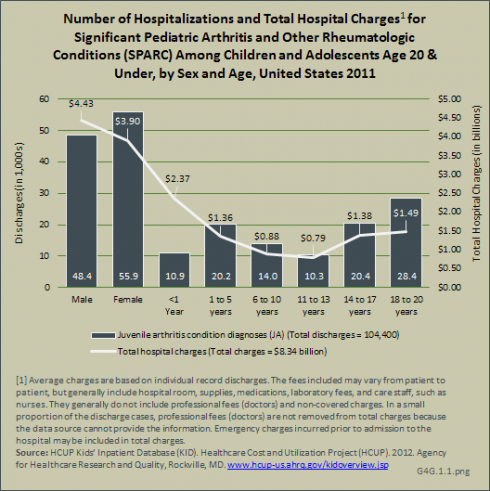

Juvenile arthritis (JA) is an umbrella term used to describe a number of autoimmune and inflammatory conditions that can develop in children.
The most common form of JA is Juvenile Idiopathic Arthritis (JIA), formally called juvenile rheumatoid arthritis (JRA) or juvenile chronic arthritis (JCA). Juvenile idiopathic arthritis is diagnosed in a child less than 16 years of age with at least 6 weeks of persistent arthritis. There are seven distinct subtypes, each having different symptoms and association to the child's autoimmunity and genetics.1 Certain subtypes are associated with an increased risk of inflammatory eye disease (uveitis). Understanding the differences in the various forms of JIA, their causes, and methods to better diagnose and treat these conditions in children is important for future treatment and prevention. Among all subtypes, 40% to 45% of children with JIA still have active disease after 10 years.2
Because of the various forms of JA, estimates of prevalence and incidence are difficult to identify. Overall estimates are that 300,000 children in the United States are diagnosed with JIA.3
In 2006, the CDC Arthritis Program finalized a case definition for ongoing surveillance of pediatric arthritis and other rheumatologic conditions (SPARC [1]) using the current ICD-9-CM diagnostically based data systems.
Analysis of recent national health care databases using the SPARC showed that 61,800 children age 17 years and younger were discharged from a hospital with any diagnosis of SPARC in 2011. Of those, 17,000 (more than one in four) had an admitting diagnosis of SPARC. Distribution was evenly split between males and females, but children age 6 years and younger were more likely to be hospitalized with a diagnosis of SPARC than older children, accounting for 45% with any SPARC diagnosis and half with an admitting SPARC diagnosis. Only a small number of children (3.2%) discharged with any diagnosis of SPARC had a diagnosis of juvenile idiopathic arthritis.1 Females accounted for 70% of discharges with a diagnosis of JIA, with 50% of the discharges for children age 13 to 17 years.
Hospital stays of nearly 9 days (mean of 8.6 days) were found for any diagnosis of SPARC. Children age 6 years and younger had a mean hospital stay nearly twice that of children ages 7 to 17 years, resulting in higher mean hospital charges. Children with a diagnosis of JIA had hospital stays of a mean of 3.6 days, with subsequently lower mean charges.
Total hospital charges associated with any diagnoses of SPARC in the population age 17 years and younger were $4.45 billion in 2012. (Reference Table 4.16 PDF [4] CSV [5])
Emergency rooms saw 443,000 patients ages 1 day to 17 years with any diagnoses of SPARC in 2010. Among these patients, 5,400 had a primary diagnosis of JIA. Females and those ages 13 to 17 years were most likely to have juvenile idiopathic arthritis.
Due to smaller sample sizes in the currently available databases for physician office visits and outpatient clinics, outpatient visits for a diagnosis of SPARC in the juvenile population are difficult to quantify. Physician visits for treatment of JA for the years 2008 to 2010 averaged just over 1 million per year. Evenly split between males and females, 60% of the visits were for children ages 13 to 17 years. Because of small sample sizes, the number of visits with a diagnosis of JIA was unreliable.
Outpatient clinics saw 282,500 patients, on a yearly average, for these same years. Patterns for distribution by sex and age reflected that of other treatment sites. However, a larger share of these patients (17%) had a diagnosis of JIA.
From these data, an estimated 1.8 million outpatient visits for any diagnoses of SPARC occurred in those 1 day to 17 years of age in 2010. (Reference Table 4.16 PDF [4] CSV [5])
Links:
[1] http://www.cdc.gov/arthritis/data_statistics/case_definition/pediatric.htm
[2] http://www.arthritis.org/arthritis-facts/disease-center/juvenile-arthritis.php
[3] http://www.cdc.gov/arthritis/basics/childhood.htm
[4] https://bmus.latticegroup.com/docs/T4.16.pdf
[5] https://bmus.latticegroup.com/docs/T4.16.csv